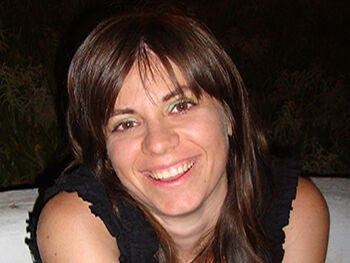UNIVERSITY NEWS LAST UPDATED : 15 APRIL 2015

Q: Could you introduce yourself, what course you are currently studying and how you are finding it?
A: Hello, my name is Anastasia Nikologianni and I’m a PhD student in Landscape Architecture at Birmingham City University. The opportunity for this PhD came along with the funding from Climate KIC. I have just finished my first year which is quite exciting and the research is going well at the moment and we have lots of things to follow.
Q: What made you choose to do a PhD at Birmingham City University?
A: I was doing the Masters in Landscape Architecture as well so I had the experience of the university, of the tutors and the whole atmosphere was really good, so I really enjoyed the environment first of all. Then I was working together with my current supervisor Professor Kathryn Moore on some projects when the opportunity for this PhD came along and it was something that I was very interested in. I applied, got through the process and I was really interested in this particular PhD because it combines research and also requires entrepreneurship and climate change, because it’s funded by a public private partnership which is Climate KIC.
Q: What would you recommend or suggest for people considering studying a similar course to you?
A: I would say that the university is quite nice, the feeling that I get is that the relationship between the tutors and the students is really good. Also, something that I really like and was an influential part of my decision to come to Birmingham City University initially was the strong links with the practices, the business world, not only in Birmingham but in the UK in general. We have visiting tutors and experts coming in on a regular basis, if feel that this is important at either undergraduate level or post graduate level. It gives you this sense of not only in the research or the academic study but also the practice as well. You get the experience from these people to be able to use it in your work.
Q: How do you feel that the facilities and the staff at Birmingham City University have influenced your career progression and knowledge of the subject?
A: The tutors in landscape architecture are really good, all of them. They are very experienced and have been doing it for a long time. Even the new people that are coming in to teach or the visiting tutors are being introduced by the older staff so I think that goes well. In terms of the facilities, I am lucky enough that we are in a very new building, Parkside is brand new so I think everybody knows that all the facilities are great and as part of the university we are allowed to use any kind of work, even if they don’t strictly belong to landscape architecture, so photography studios, printing rooms, so yeah that facilities are really good. We need these brilliant facilities to take our work to another level.
Q: How is your current exhibition going? What is it specifically looking at? What sort of projects are you exhibiting?
A: The exhibition is the first step of my research, so the whole research looks to what extent low carbon or sustainability can be expressed in regional design landscape strategies, and I am looking at the role of drawing in the process. The exhibition is the identification of these ideas, so what do we talk about when we say 'low carbon' or 'sustainability' on a huge landscape scale. I have chosen the Wolfson Economics Prize 2014, where the main question was about the housing problems of the UK and how we can create garden cities that are economically viable and feasible as well as being attractive to the people. There were 279 entries in that competition and I have narrowed it down to the finalists and the exhibition located in Parkside is looking at the finalists and what their main ideas were in terms of regional design, urban design, sustainability and how we can actually match what I know and what I would like to do in order to move this forward in terms of landscape and in terms of design.
Q: Have you had any high-profile guests attend your exhibition?
A: I have to say that I was quote lucky in that I had quite a few people coming in. Of course we had professors and tutors of the university. I also had people from Birmingham City Council, Solihull Metropolitan Borough Council, landscape architects and engineers working on HS2, we had quite a few from big landscape practices and engineering practices and also wildlife trusts and canal trusts of the area.
Q: What’s your favourite part about the course?
A: The Masters course was really nice as it introduced me from quite a scientific, hands-on background, this was another reason why I came to this university because I wanted a more artistic way of thinking, which is absolutely necessary in landscape architecture. It wasn’t easy as I was coming from a totally different perspective, but this way of seeing things differently was what I liked. My PhD is a bit more theoretical, I really like finding out more about work that has been done in this field, either landscape or sustainability. I really enjoy the fact that I have the opportunity to discuss with practices, which again links the connection between entrepreneurship and academia. This is what I really like, as I don’t want to be just academia or just practice, this merges something that I am fascinated by.